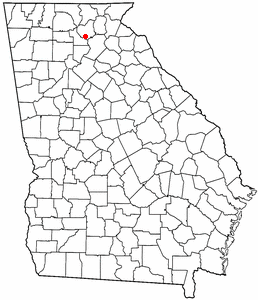Auraria, Georgia facts for kids
Quick facts for kids
Auraria
|
|
|---|---|
|
Ghost town
|
|

A store named Woody's
|
|

Location of Auraria, Georgia
|
|
| Country | United States |
| State | Georgia |
| County | Lumpkin County |
| Elevation | 1,398 ft (426 m) |
| GNIS ID | 354415 |
Auraria is a ghost town in Lumpkin County, Georgia, USA. It is located southwest of Dahlonega. The name Auraria comes from the Latin word aurum, which means gold. Long ago, people also called it Dean, Deans, Nuckollsville, or Scuffle Town.
History
The Gold Rush Begins
Thousands of people came to this area looking for gold. This happened during the Georgia Gold Rush. Many arrived after the Gold Lottery of 1832. Auraria became one of the first boom towns in June 1832. William Dean built a cabin here. It was between the Chestatee River and Etowah River.
Auraria was the temporary county seat for Lumpkin County in 1832. Nathaniel Nuckolls built a tavern and a hotel. He also built other buildings for miners. Six months after the lottery, the town grew fast. It had about 100 homes and many stores. There were also law offices and taverns. By May 1833, about 1,000 people lived in Auraria. The county had 10,000 people.
A New Name
Vice President John C. Calhoun bought land east of Auraria. He started the Calhoun Mine there. In November 1832, a friend of Calhoun suggested a new name. He thought the town should be called Aureola. But the town citizens chose Auraria instead. This name was suggested by John Powell.
Many mines were located near Auraria. They were along the Etowah River, Camp Creek, and Cane Creek. Some famous mines included Barlow Mine and Battle Branch Mine.
Decline and New Discoveries
The main land where Auraria stood was won by John R. Plummer. But there was a question about his right to the land. Because of this legal problem, judges chose a new county seat. They picked a spot north of Auraria. This new place was near the Cane Creek mining area.
Auraria quickly became smaller. Businesses and county offices moved away. The first court session for Lumpkin County met in the new town. This town became known as Dahlonega, Georgia. It happened on August 22, 1833. Dahlonega also got a special federal mint for gold coins. This was due to its location and political power.
In 1848, gold was found in California. A former Auraria resident, Jennie Wimmer, was a cook there. She was the first person to confirm the gold was real. She knew how to test for gold. This discovery started the California Gold Rush of 1849.
Finding gold in California and later in Colorado changed everything. Auraria slowly faded away. Gold mining in Georgia decreased a lot. Miners went west to find new gold. Auraria's population dropped quickly. The community fell apart.
In 1858, William Greeneberry Russell and others from Auraria went to Kansas Territory. They started a settlement in Colorado. This new town was also named Auraria. It later joined with Denver.
Present day
Today, only a few old buildings remain in Auraria. Woody's store is still there on Castleberry Bridge Road. It stayed open until the early 1980s. There is also a red house that used to be a bank. Another house stands across the street. You can also see a couple of old building foundations. These old structures are a reminder of the 19th-century gold rush.
Geography
To visit Auraria, start from the square in Dahlonega. Take the west road towards Dawsonville. You will pass the college. The gold-domed building is built on the old mint's foundation. Turn left at the bottom of that hill. Continue for about 3 miles. The old red house on your left was the bank. After it, a collapsing building was the old hotel. Just beyond that, on the left, is the old Woody's store. Castleberry Bridge Road is to the right. It leads down to the Etowah River.


